#lamashtu
Text


~ Plaque of conjuration against the Lamashtu, called "plaque of the underworld" or Hell Plate.
Period: Neo-Assyrian (1st half of the millennium)
Place of origin: Assyria
Medium: Bronze
#ancient#ancient art#history#museum#archeology#ancient sculpture#ancient history#archaeology#assyria#assyrian#plaque#Lamashtu#conjuring#underworld#hell plate#Neo-Assyrian#bronze
2K notes
·
View notes
Text
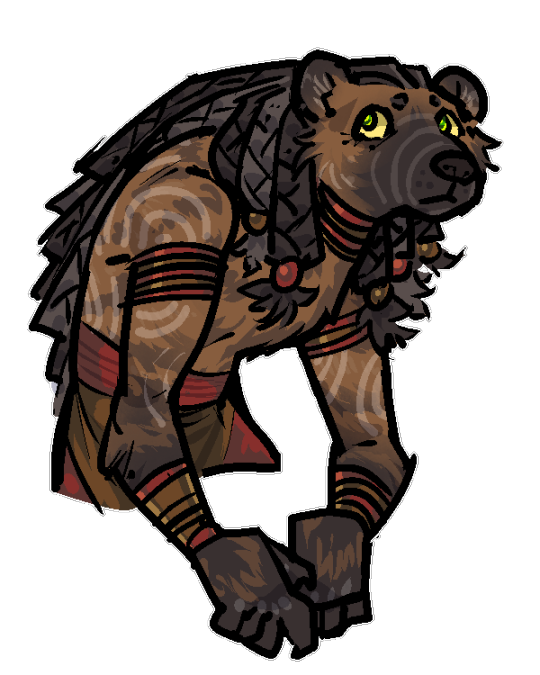
Gr'alla, an NPC in my pathfinder 2e game. She's a devoted priestess of Lamashtu and the second last surviving member of her tribe. Be nice.
810 notes
·
View notes
Text
The Great Game
The galaxy is sick, and has been for so long that even most of the gods have forgotten what it was like when it was healthy. If a cosmology is like an ecosystem, Golarion and its surrounding worlds have too many predators, not enough prey, too much competition, not enough mutualism. The Material Plane is a little too similar to a chaotic, evil world—like the Abyss specifically. On Golarion, it’s kill or be killed.

The reason is Lamashtu. In ages past, the Mother of Monsters ambushed Curchanus, stripping from him the portfolio of Animals and leaving him for dead. He survived long enough to pass his domain of Travel to his protégé, Desna, but Lamashtu was able to use that surge of power to claim divinity for herself and become the Queen of Demons. Since then, Lamashtu has done as she willed, fighting and fucking her way across reality and leaving thousands of new species of horrors in her wake.
But Lamashtu is a neglectful mother. Because of her influence, animals in the Material Plane are overly hostile, too aggressive, liable to pick fights that they can’t win. Animals are liable to view humanoids as prey, which leads to savage reprisals and environmental catastrophe. The species created by Lamashtu and her followers, both demonic and mortal, are born without a niche, and their shoving into the world around them leads to disruption and devastation. It’s not a coincidence that crazed wizards and misguided druids have brought so many new monsters into existence, and that one-off horrors are liable to mutate and become entire species.
But this has not gone unnoticed.
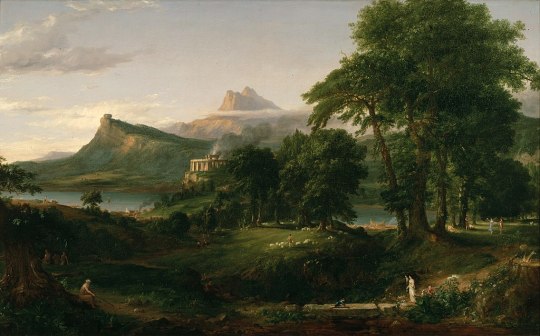
Deep within the First World lives a goddess. A Goddess of Predators, although she is only quasi-divine. For now. Mormo, the First Medusa, Goddess of Predators, has been alive since before the Age of Serpents, since before the birth of mammals. She is a primordial entity, a Great Old One, although more benevolent than most. She and Yig call each other Brother and Sister, although this may or may not represent a genetic linkage. She retreated from the Material Plane as humanity became a growing power, disgusted by the callousness of the Azlanti and the machinations of the aboleths.
But now she has chanced to gaze upon the Material again. And is horrified to see how much things have gotten worse in her absence. Mormo wants to help. And to help the best way she knows how. By killing and eating something. Someone. Lamashtu.
Mormo’s ultimate goal is to do to Lamashtu what Lamashtu did to Curchanus. Weaken her to the point where she can be fought, strip the domain of Animals from her, and ideally kill her for good. Leave the demons without a Queen, so they can go back to clawing at each other’s throats for a while. Restore the ecological balance of Golarion and allow the biological exuberance of the First World back onto the Material Plane.
But she needs help. And Lamashtu may be confident, but she’s not complacent. She knows that Mormo is gunning for her. And is bringing together allies of her own.
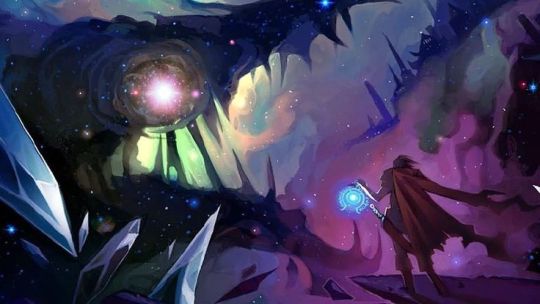
This is the Great Game, the cosmological underpinnings of the Age of Monsters. Gods, demigods and other entities are picking sides, or choosing to remain neutral, or remaining neutral on the surface but shoring up their favorites in secret. The teams are not defined by alignment. There are those of all alignments, of all of the planar power groups, who support Team Lamashtu or Team Mormo, in large ways or small. Any conflict where Desna and Pazuzu both have the same enemy is bound to get complicated, after all. Further articles will be posted throughout the year, tagged with The Great Game, discussing who is on who’s side, and why.
Full statistics for Mormo are forthcoming—those are likely going to be the capstone of Monster Girl Summer, posted in August. Mormo is a N great old one, with the portfolio of reptiles, terror and ecology. Her domains are Knowledge, Scalykind, Strength and Trickery, and her subdomains are Competition, Fear (modifying Trickery), Thought and Venom.
#pathfinder rpg#pathfinder 1e#age of monsters#the great game#lamashtu#mormo#in this corner#cosmology#D&D#tabletop rpgs#demon lord#great old one
178 notes
·
View notes
Text
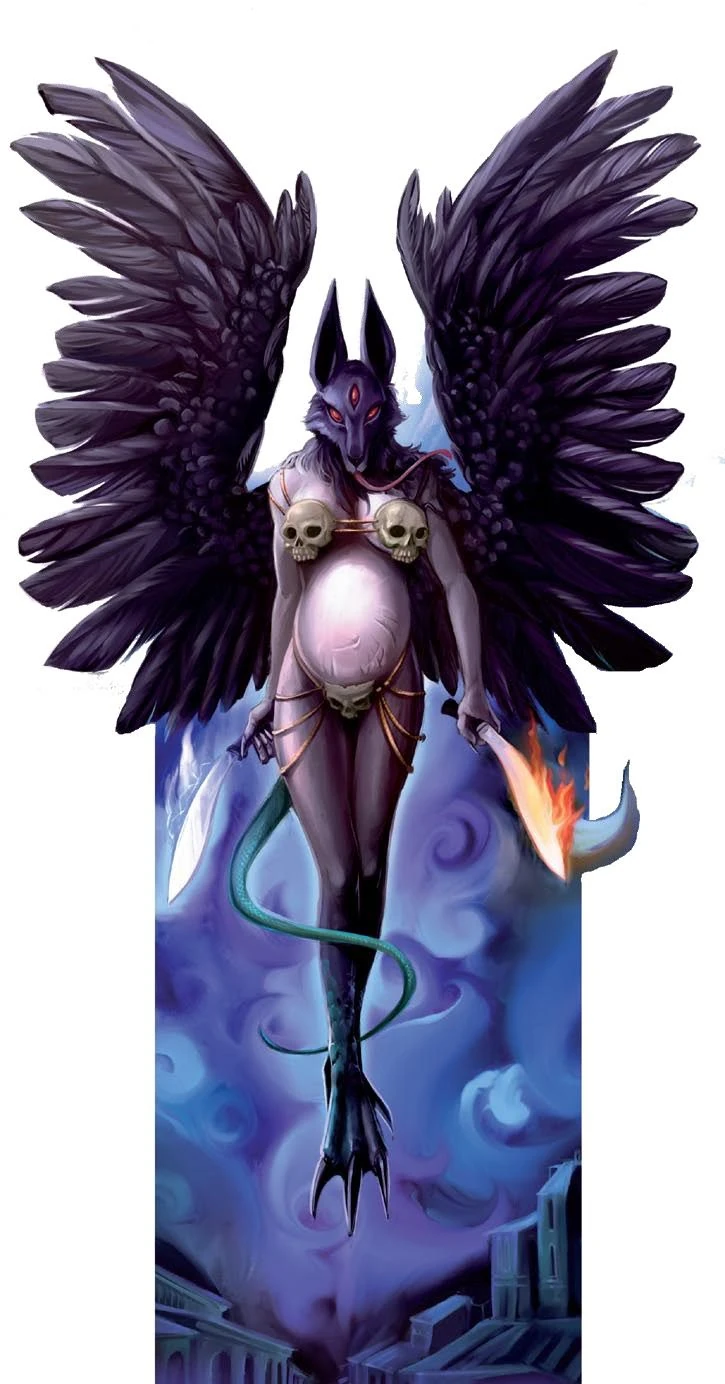
"Literally the goddess of monster fucking; eternally pregnant MILF has to be someone's fetish; furries might like her"
19 notes
·
View notes
Note
I've got a question related to some character building I'm doing. Would there be some close equivalent or name to describe someone who thirsts for blood, or drinks blood? An ancient blood thirst, or a demon or god that thirsts for blood? Secondarily, any fun names or nicknames for people who sing songs/hymns?
Hello! The key example of a blood-drinker in Mesopotamian myth is the malevolent goddess/demon Lamashtu, a daughter of Anu known as an antagonist of women in childbirth who would drink their blood and eat their bones. Lamashtu is her Akkadian name; in Sumerian she's Dimme, written 𒀭𒈕𒃶 among other variations. There isn't evidence in Sumerian literature for anything like vampires or a class of blood-drinkers that I can find, but the basic terminology would be ush nang 𒌀𒅘 "to drink blood". "One having drunk blood" would be ush nanga and "one drinking blood (right now)" is ush nana.
There are a number of Sumerian words for singers of various types. The most general is nar 𒈜 "musician, singer", while others include gala 𒍑𒆪 "ritual singer", balangdi 𒁆𒁲 "lamentation-singer", lushirra 𒇽𒂡𒊏 "dirge-singer", and words like eshtalu 𒀊𒋫𒇽 which refer to a type of singer, but we don't know what kind. One of my personal favorites is zeza 𒍢𒍝 "singer of croaking sounds" - I think we all know a singer like this!
35 notes
·
View notes
Note
I saw a post on how Lilith and Lamashtu are connected, what is your opinion on it?
I saw this post, and I quite liked it, although I do have some comments.
First, I'd like to point out that the only academic paper I have found (and the only one that is cited by online sources, like Wikipedia and everything else that mentions Lilith within an article on Lamaštu) is "The Transformations of a Goddess: Lillake, Lamashtu, and Lilith" by Wendilyn Emrys. This work has not been peer reviewed, and its author has not yet received a doctorate. Skimming through the document, I can say that its writing is much more casual than your average academic paper. However, it is fairly thorough. I would like to also highlight that its author when out of her way to read an unnamed book on Lilith at a Jewish charity event, citing not-so-great reactions to that as results of Judaism being highly oppressive and "putting extreme constraints on the simple joy of sexual love between partners". That's the most important thing I want to highlight.
The first paragraph of the post is highly important, highlighting the closed nature of Lilith, her Jewishness, and the fact that Lilith is not a Mesopotamian goddess. Too many gentiles love to gesture wildly at the Burney Relief as "proof" that Lilith was some sort of Sumerian goddess as if it hasn't been well-known for ~50 years that it has absolutely nothing to do with Lilith.
The post does synonymize Lilith and Lamaštu slightly more than I would think is accurate, because they have become separated by hundreds of years of separate development. It is not incorrect to think that they are related in some way, as the evidence does absolutely point to such. I also think that boiling Lilith down to the "Jewish version of Lamaštu" is too much of a blanket statement. That's my biggest "issue" with it, but it's not that big of a deal.
I appreciate the non-Jewish "alternatives" to Lilith that are given (i.e.: figures that are actually what gentiles are looking for in Lilith), and it gives a very good rundown of said figures.
That's about it! The post is doing what it's meant to, and I appreciate its goal. I hope I could provide the info you were looking for.
#askcarver#carverop#references#judaism#jewish#jumblr#demonology#appropriation#antisemitism#לילית#lamashtu#sumerian
46 notes
·
View notes
Text
New Year, New Deity, Day 11: Cleric of Lamashtu

Gnoll joke, it's day 11 already, and it's time to look at what a cleric of Lamashtu, the Mother of Monsters, would look like. The build devoted to everyone's favorite monster mommy is below:



As a Gnoll Beastkin (flavored as a bat) with the Oozemorph dedication, you're already sufficiently monstrous, while spells such as Animal Form and Adapt Self help push this theme. Your array of senses and abilities help ensure you can guide your allies through difficult or hostile areas, while your suite of Harm spells, in tandem with Cast Down and Harming Hands, ensure your font is particularly effective at dispatching those that would stand in your way.
Full Build Linked Here!
7 notes
·
View notes
Text
youtube
A great talk on spirits, ghosts, and witches in Ancient Mesopotamia, including some of my faves like Lamashtu and Pazuzu.
13 notes
·
View notes
Text
Less Lilith Appropriation...
More Lamashtu Appreciation!
🩸💙🐍🦁🐍💙🩸

~ Image Credit ~
#lamashtu#lilith#demonolatry#demonology#appropriation#cultural appropriation#stop appropriating lilith#mesopotamia#mesopotamian religion#sumer#ancient mesopotamia#hail lamashtu#i actually love lamashtu so much asdfghj#paganism#daimonic paganism#deities#mythology#goddess worship#demons#pagan#demonic entity#mesopotamian deities are literally the coolest fffff-
53 notes
·
View notes
Text
Pg. 5: Anemo Consort's Veil


(MODEL: Isja "Coldgaze" Kaltablik)
Majestically floating its way into the realm of high fashion comes a wispy habiliment teeming with wind-aspected materials. With an ever-billowing trail and headdress, this item has been dubbed the Anemo Consort’s Veil.
“Anemo” being an archaic synonym for wind, this piece was inspired by a powerful Voidsent consorted into nobility known as Lamashtu, who is said to haunt the Isle of Val. The eerie beauty of the selfsame woman has been captured and immortalized in this garb, which can be worn for any occasion - formal or otherwise.
The scintillating blue glow is a sign of the Voidsent’s lingering essence, giving the dress a near-perpetual flow that would make one seem as though they were gliding amidst the floor. The golden gorget and gothic thigh-highs culminates this attire with some Thanalan-esque style.
Fit for a bride; fit for a lady; fit for a master of the wind. The Anemo Consort’s Veil is one of this line’s many highlights, and will glide among the zephyrs of the haute couture realm.
Note: Due to its heavy wind aspect, this ensemble has been tested to enable flight for the wearer at some capacity. Please utilize at your own risk.
(Credit and thanks to Stefany for the creation of this masterpiece!)
#thiji higuri#higuri regalia#ffxiv#high fashion#fashion#ffxiv a realm reborn#lalafell#pib catalogue#ffxiv rp#haute couture#the abyssal gala#voidsent#eureka#lamashtu#veena viera#ffxiv viera#ff14 viera
4 notes
·
View notes
Text
Other curiosities about Pazuzu
Part 3 of my series of posts, this one though unrelated to Castlevania.
(part one here, two here)
Pazuzu, while named the "Agony of Mankind", "Suffering of Mankind", and "Disease of Mankind", and had spells/prayers warding against him, or appeasing him, Pazuzu also had a somewhat positive aspect to him, as when invoked in spells, protected against other Lilu demons under his command. Including his hated rival the demon goddess Lamashtu:
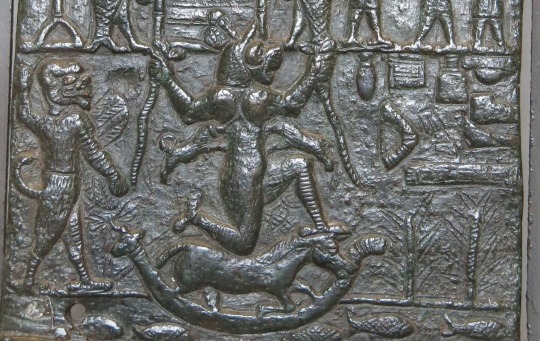
Depiction of Pazuzu fighting Lamashtu on a Protection plaque against her, Neo-Assyrian period, Louvre museum.
Lamashtu though was longer associated with Lilu and Lilitu demons, Lilitu being even one of her names (suggesting the singular Lilith of latter Abrahamic texts is partially derived from her).
Pazuzu had also some other curious traits, like possessing a scorpion tail...and having a serpent for a penis:

Pazuzu also seems to have influenced the Aramaic incantation bowls magic and demonology (which in turn influenced the latter Christian and possibly Muslim demonology and magic). There the role of Pazuzu (who was invoked to protect against Lilu and Lilitu demons), is given to Asmodeus/Ashmedai, who also is presented as the king of Liliths, and also invoked to protect against them. From Pazuzu, Asmodeus seems to have also inherited avian feet, which has already on the incantation bowls, and are also present in latter depictions:

Depiction of Asmodeus/Ashmedai from an Aramaic Incantation Bowl.

Asmodeus as depicted in Collin de Plancy's Dictionnaire Infernal, 1863 edition.
It also should be said all points out Pazuzu himself is an Assyrian continuation/adaptation of the older Sumerian/Akkadian demon god - Anzu.
Anzu (though his name should be probably read in Akkadian as "Zu", with "An" being a misreading of the cuneiform An/Dingir signifying divinity. Sumerian pronunciation of his name being Imdugud) is an entity from very early Mesopotamian mythology, presented first as lion headed bird, then as a lion-dragon (a kinda griffin like creature):

depiction of Anzu from around 2500 BC.

Ninurta fighting Anzu (depicted as a lion-dragon)
These traits are visible in Pazuzu, who also has a avian and leonine traits, if being more humanoid, but also seeming more demonic.
Anzu's role in myth is interesting, as he is presented as an almost "Luciferian" figure - he was a servant of the higher gods, until he rebelled against the King of Gods Enlil, stole the Tablets of Destiny allowing for control over the universe. Gods feared confronting Anzu, until one god - Ninurta, Ningirsu or Marduk depending on version - finally challenged Anzu and defeated him, retrieving the tablets (with the version with Marduk, it's an alternate story to his fight with Tiamat, how and why he was crowned the king of gods).
Aside from similarities to the story of Satan (if more the post Biblical version, though one that has foundations in at least New Testament (specifically the Book of Revelation), as well Apocryphal Jewish texts like the Book of Enoch or Life of Adam and Eve), it also might have influenced the stories of the Greek Demon Monster Typhon, and the Egyptian god Set.
Like Typhon, Anzu is born to Earth (Ki) and the Abyss (Abzu) (Gaea and Tartatus for Typhon). Anzu was born, and resided at mountain Sarsar, some thinking it is the source of the Greek Tartarus. Both Typhon have also power over storm, wind and fire (though Anzu also had power over water, disease and pestilence). Via Sarsar (and the Sutean people living there), and the Anzu is also connected to Set, or at least his gradual demonization (including the fact Greeks themselves equated Set with Typhon) (both connections to Typhon and Set being kinda elaborated in this academic paper).
Depiction of Anzu and Pazuzu seemed to have also influenced the depictions of Angra Mainyu/Ahriman in Zoroastrianism, as well as possibly Pazuzu also influencing the depictions of Ahriman in Mithraism (and possibly latter Zoroastrianism).
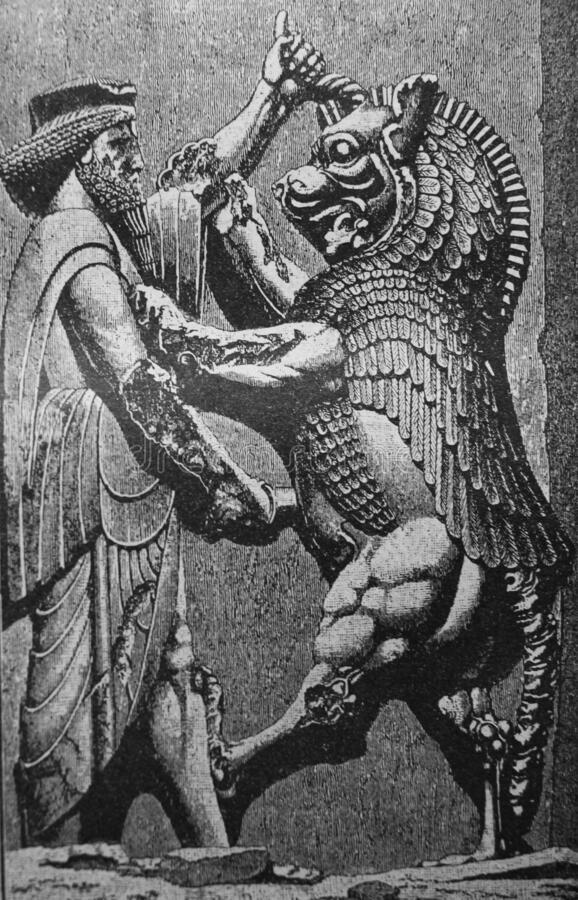
Ahura Mazda or a Persian King fighting Angra Mainyu/Ahriman or a monster symbolizing him. Note similarities to the scene of Ninurta fighting Anzu, and strong similarity to Anzu, while also having horns and scorpion tail associated with Pazuzu.

Mysterious lion-headed figure of Mithraism. Some think it is Arimanus (Ahriman) also mentioned in Mithraic inscriptions. Note also presence of 4 wings, and being encircled by a serpent, calling back to Pazuzu's serpentine phallus.
Returning to Dungeons and Dragons, Pazuzu's lore was greatly expanded in 3rd and 4th editions.

artwork of Pazuzu from 3rd edition, Fiendish Codex I - Hordes of the Abyss
In 3rd edition it was stated one of Pazuzu's names is Imdugug, though Anzu is a name of a demon species serving Pazuzu. Another of Pazuzu's names, was established to be also Typhon.
But more importantly, Pazuzu was established as a member of the Lovecraftian Obyriths - demons older than gods and mortals, older than the current demon species, and who created the Tanar'ri (the main group of current demons, and first one after Obyriths).
(Note that Pazuzu being a "proto-demon" was an idea by Gary Gygax himself, though up until 3rd edition only present in his Gord the Rogue novel series that latter parts weren't considered canonical to D&D lore.)
4th edition further expanded on that, depicting Obyriths as coming from an older multiverse, they destroyed and devoured. Pazuzu is described as the great manipulator who manipulated and corrupted the god Tharizdun into becoming what he is (a Lovecraftian monster endangering the whole existence), and by this caused also the corruption of the Elemental Chaos, formation of the Abyss and war between Gods and Primordials, and caused the existence of other fiends. Pazuzu also persuaded and corrupted the angel Asmodeus to fully fall, created the devils and the Nine Hells. Basically, he was more or less established as the Bigger Bad of D&D, at least during 4E, especially on Nerath.
(Fun fact, Exandria is largely derived from Nerath if with elements of Oerth and other settings)

Pazuzu and other Obyrith Lords - Ugudenk, Dagon, Obox-ob, and Pale Night
Indeed, Pazuzu plays a somewhat Nyarlathotep-like rol among Obyriths, being more similar to creatures from the current multiverse in many ways, and adopting a less horrific appearance, as well as being a great manipulator.
So due to this, I think it was even more fitting Pazuzu was originally chosen to be connected to Dracula, even source of his powers and vampirism, though as mentioned, latter his role became very ambiguous.
#pazuzu#anzu#lamashtu#mesopotamian mythology#assyrian#asmodeus#typhon#set#ahriman#angra mainyu#mithraism#dungeons & dragons#d&d#obyrith#sutekh
59 notes
·
View notes
Text

July 1, 2023:
Abyss Tertiary, Pearlcatcher, Iridescent.
Lamashtu from AbyssalEve's Den of Pestilence!
12 notes
·
View notes
Text
Part 2: 2/3 "Looking around"
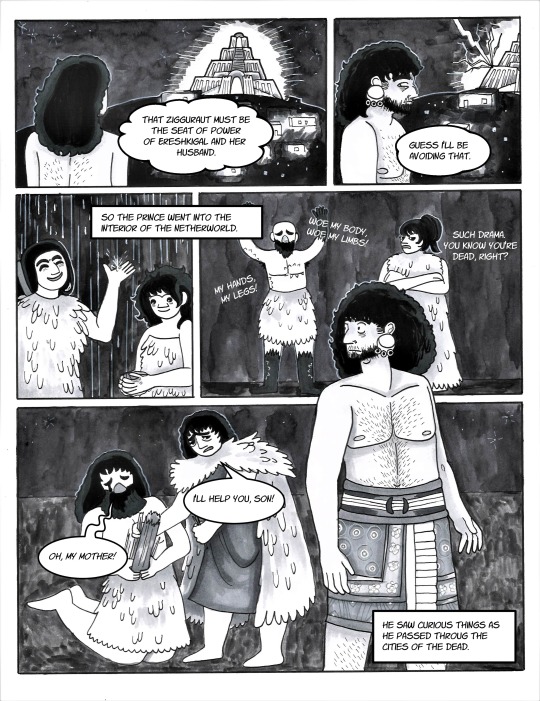







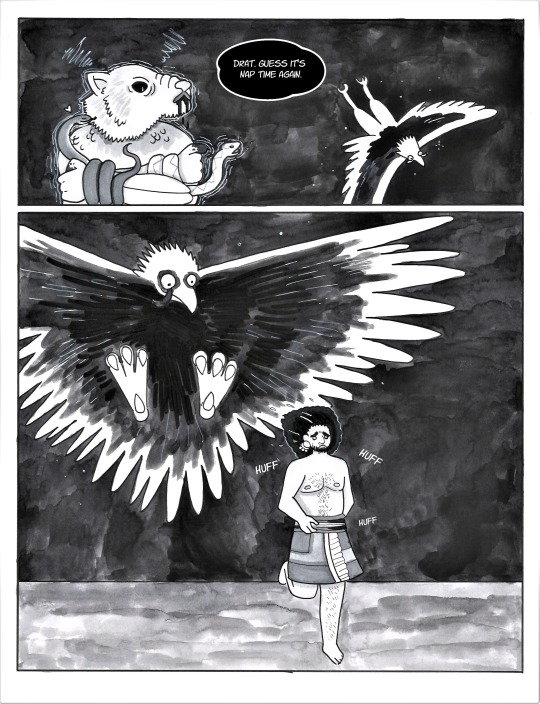

Lamashtu cameo time
35 notes
·
View notes
Text
The Great Game: Outer Gods and Great Old Ones
As the deities that are most physically tied to the Material Plane, it is perhaps unsurprising that the various entities collected together as “Outer Gods” and “Great Old Ones” have been paying attention to the Great Game. The allegiances of some of the prominent members of these pantheons are as follows:

Abhoth
The Unclean God is patron of disease and fecundity, and knows how these two things are tied together. More are born than can survive, and many of those that die fall to disease before anything else. As such, Abhoth is well versed in ecology, and knows that Lamashtu is overpopulating Golarion with her monsters. Abhoth’s followers seek to spread plagues among monstrous species in order to keep their numbers down, and as such, Mormo counts Abhoth as an ally.
Azathoth
The Primal Chaos does not seem to have noticed the Great Game, or much of anything that has happened on Golarion in centuries. This is probably for the best. If any of his attention were to be turned onto the conflict, it could easily become a disaster for both parties…something that Nyarlathotep is hoping for, and working to make happen.

Bokrug
The Water Lizard fondly remembers Mormo from before the evolution of true mammals, and they have hunted and sparred together and even mated in the past. Bokrug may be difficult to rouse from his slumber, but his ire is terrible when provoked, and is likely to be directed at the followers of Lamashtu.
Cthulhu
The Dreamer in the Deep has dreamt of Golarion, and one or two of his star-spawn have come there. But he cares not for the Great Game; he has his own stars that need to be right once again. A star-spawn of Cthulhu is a dangerous agent of its own right, and one more likely to support Lamashtu than Mormo.

Hastur
The King in Yellow respects Lamashtu and her ravenous appetites. Although he has his own plans to absorb chunks of Golarion, or the whole world if he can, into the Nightmare Kingdom of Carcosa, he is at least nominally on the Mother of Monster’s side. As long as their cultists can keep sharing the same sybaritic festivities.
Ithaqua
Ithaqua is more concerned with consuming anyone on either side that he can sink his talons into. The Wind Walker is slightly more favorably minded towards Lamashtu than Mormo, but any relationship between their cults is likely to be a tenuous one that could break down into ravenous hunger at any point.
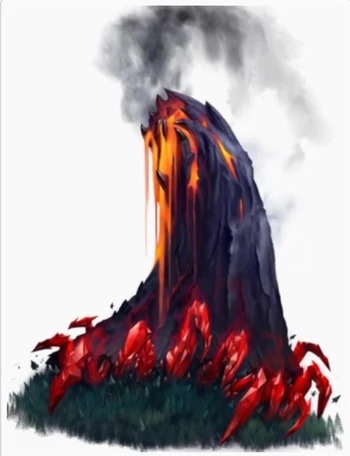
Mhar
Mhar wants off of Golarion. He sees a change in the status quo as the best way of achieving that goal, and is resentful of lamia clerics of Lamashtu for helping Karzoug the Runelord to build a palace on his surface and deface him. Mhar’s release would likely be devastating for Mormo’s goals of making Golarion a richer and more diverse ecosystem. But on the other hand, volcanic ash and lava rock makes for excellent fertilizer, and his eruption might not be as destructive as he hopes it will be.

Nhimbaloth
As a devourer of souls and a corrupter of wild things, Nhimbaloth is an ally of Lamashtu. Of course, she does respect Mormo’s goals of eating Lamashtu as a fellow apex predator. But Nhimbaloth thinks that the Goddess of Predators is too arrogant and needs to be taken down a peg. Nhimbaloth would happily eat Mormo herself if given half a chance, and for that reason, Mormo keeps a wide berth of Nhimbaloth’s home world, Voidbracken.
Nyarlathotep
The Crawling Chaos is delighted by this galaxy spanning conflict, and on the surface is playing both sides. Lamashtu is his real dog in the fight, as he views Lamashtu as being more likely to lead Golarion to ruin, cracking open and releasing Rovagug. That would be a fun show to watch, seeing how the Rough Beast would react after eons of imprisonment. The Mask of Nyarlathotep that is most actively involved is the Black Pharaoh, whose cults are pushing technological advances into the hands of demon cultists and dangerous maneaters.
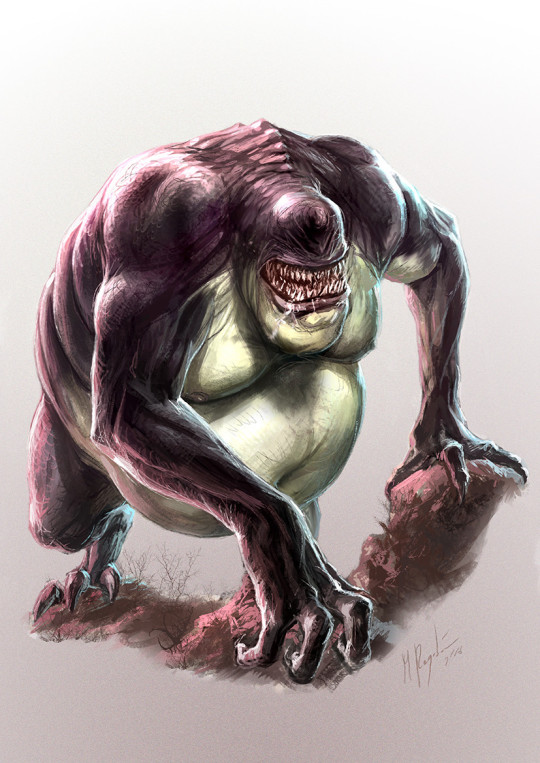
Orgesh
The Faceless God is technically on Lamashtu’s side, although not by any direct aiding or abetting. Orgesh wants to fight Mormo himself. And is sending his chardra to pick fights with her worshipers, and is gunning for her most powerful servitors himself, in the hopes of getting Mormo’s attention. Worst case scenario, Orgesh will be killed and be able to respawn on another planet. Unless Mormo gets sick of his interference, and starts doing research on a way to kill him for real before setting her sights higher.
Shub-Nugganoth*
The Goat of the Woods views Lamashtu as a kindred spirit, and the two of them have indeed collaborated on the spawning of horrors in the past. They are doing so again, notably through the personage of one of the Goat’s most powerful mortal worshipers in Avistan, a fleshwarping-obsessed alchemist named Doctor Agatha Shiny. Doctor Shiny and her creations are actively hunting down Mormo’s allies in order to transform them into blasphemous horrors, or just murder them.
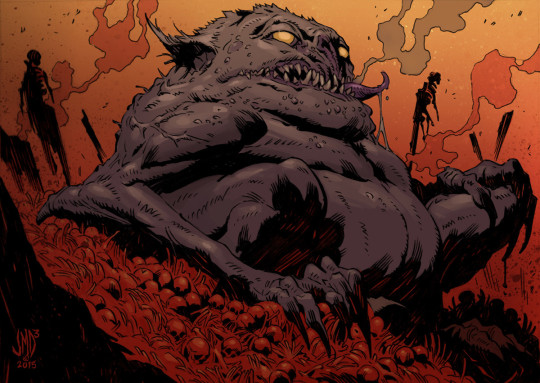
Tsathoggua
Saint Toad knows what it’s like to be forgotten and abandoned. He is a supporter of Mormo, if only because she’s the underdog in this fight, and Tsathoggua has a soft spot for underdogs, as much as he would deny that. Mormo knows that the Father of Night is a fickle and somewhat dangerous ally, so doesn’t rely on his help, but does appreciate his guidance and wisdom.
Yig
The Father of Serpents calls Mormo “sister”, and the Goddess of Predators calls Yig “brother” in return. This may be an actual genealogical relationship, it may not be. But Yig is among Mormo’s closest allies, and the two are active collaborators. Those colonies of serpentfolk who worship Yig are hotspots for burgeoning cults of Mormo, as they see the two ophidian Old Ones as a way to reclaim some of the lost glory of the Age of Serpents without relying on the increasingly unstable Ydersius.
Yog-Sothoth
The Key and the Gate views things on a vast, cosmic scale, even more than the other Outer Gods. As such, the safety and long term stability of the galaxy is his highest priority (after all, it has to collide with another galaxy in approximately 1.2 billion years, and then enough of it has to be around to decay into degenerate matter as the universe shifts past its stelliferous era. So anything that dramatically accelerates that process, or might get large portions of the galaxy pulled out of the Material Plane altogether, are not ideal outcomes for Yog-Sothoth. As such, he supports Mormo, but is doing so in a subtle way—opening portals in the right places, weakening planar boundaries—rather than sending his children to fight en masse.
*This is the name I am going to be using for that particular Outer God in the future. Clearly the same entity that has been developed into a character by Mythos authors over the last 100 years, but doesn't have a racist slur built into the name.
#the great game#age of monsters#cthulhu mythos#outer god#great old one#azathoth#yig#yog-sothoth#bokrug#hastur#nyarlathotep#shub nugganoth#orgesh#mhar#pathfinder rpg#pathfinder 1e#lamashtu#mormo
175 notes
·
View notes
Text
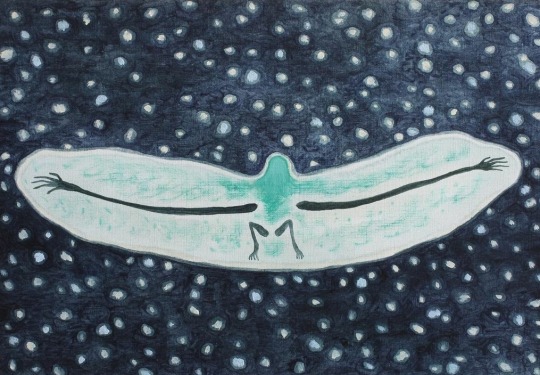
Joseph Dilnot. Winged and Faceless. 2023
Instagram: @ josephdilnot
#🖼 art#deity work#lilitu#lamashtu#wind spirit#legion#spirit work#spiritual energy#cosmic#chaotic feminine#left hand path#death#chthonic#spiritualgrowth#creatures of the night#defiance#chaos#chthonic feminine#🟣 lilitu
4 notes
·
View notes
Text



Kaikin, Demon of the Mother
None of the images above I drew, they're all commissions.
One of my favorite pathfinder characters I've played. An anti-paladin dedicated to Lamashtu, who through his actions ascended to demonhood.
Since that campaign's finished the character has taken on a life of his own. and I have very slowly been commissioning work of him, since he is pricey to commission due to the complexity and being a hybrid of armor/mecha and furry.
Credits: 1st image is by @beethereal-knight on tumblr, 2nd image by ALTERED_ZER0 on twitter, and 3rd image by @vicekillx on tumblr.

Also here's a drawing I did of him, tracing a rabbit image.
6 notes
·
View notes